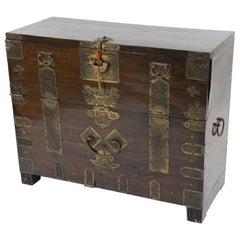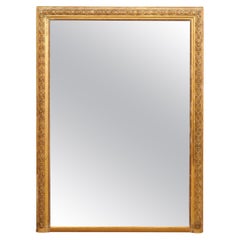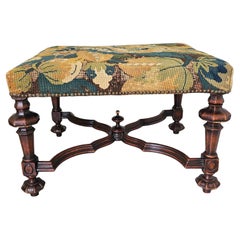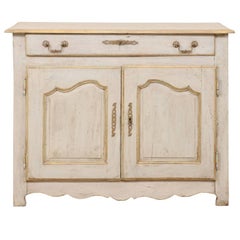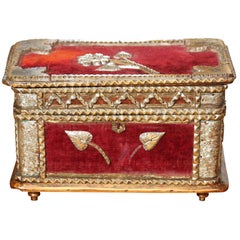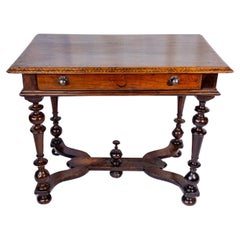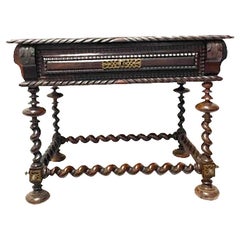Antique Furniture Wood Trim
to
15
175
6
108
56
56
22
17
12
12
11
9
4
3
2
1
1
1
1
1
1
1
1
1
1
Sort By
Antique Korean Tansu Elm Wood Chest with Brass Trim
Located in Sheffield, MA
The antique Korean Bandaji, or blanket chest is handcrafted in wood and embellished with original
Category
Late 19th Century Korean Other Antique Furniture Wood Trim
Materials
Brass
$2,900 Sale Price
23% Off
H 34.5 in W 42.5 in D 18.5 in
French 19th C. Nicely-Trimmed & Gilt Wood Mirror, 6+ Ft Tall
Located in Atlanta, GA
A large French carved and gilt wood mirror from the late 19th century. This antique mirror from
Category
Late 19th Century French Antique Furniture Wood Trim
Materials
Mirror, Wood
William & Mary Style Carved Wood and Needlepoint Upholstered Bench w/ Nail Trims
Located in Germantown, MD
A late 19th Century William and Mary Style Carved Wood and Needlepoint Upholstered Bench with brass
Category
Late 19th Century American William and Mary Antique Furniture Wood Trim
Materials
Upholstery, Walnut
$1,395
H 17 in W 25.25 in D 20.25 in
Painted Wood Buffet in Pale Blue with Gold, Green and Beige Trim--French
Located in Atlanta, GA
A French 18th century painted wood buffet. This French antique painted wood buffet features a
Category
18th Century French Antique Furniture Wood Trim
Materials
Metal
$4,000
H 40 in W 50.75 in D 22 in
velvet trimmed tramp art box
Located in Seattle, WA
charming tramp art box with mirror held by carved tab
Category
Early 20th Century American Antique Furniture Wood Trim
Materials
Wood, Fabric, Mirror
Early 20th Century European Crushed Velvet Bench Settee Nailhead Trim
Located in West Palm Beach, US
Early 20th Century Crushed Velvet Bench Settee with Wood Legs and Nailhead Trim
This early 20th
Category
Early 20th Century European Victorian Antique Furniture Wood Trim
Materials
Velvet, Wood
$3,150
H 42.5 in W 61.5 in D 22.5 in
Single Linen and Leather Trim Wing Chair
Located in Washington, DC
A single linen and leather trim wing chair.
Category
Early 20th Century French Antique Furniture Wood Trim
Materials
Leather, Linen, Wood
19th Century Italian Side Table with Walnut Marquetry Trim
Located in Houston, TX
The 19th Century Italian Side Table with Walnut Marquetry Trim epitomizes the refined elegance of
Category
19th Century Italian Antique Furniture Wood Trim
Materials
Wood, Walnut
Decorative Trim Side Table with Barley Twist Legs, Portugal, 18th Century
Located in New York, NY
.
Classic decorative trim with ornate brass details.
Barley twist legs and stretcher.
Palissandre wood.
Category
18th Century Portuguese Antique Furniture Wood Trim
Materials
Wood
$5,950
H 19 in W 24 in D 17 in
Near Pair Early 20th C Italian Ebonised Stands with Brass Trim
Located in Troy, MI
Found in Italy, these circa 1930s tall slender stands feature an ebonised finish and brass trim
Category
Early 20th Century Antique Furniture Wood Trim
Materials
Brass
Early 19th C. Italian Upholstered Sofa w/Garland Carved Trim Accents
Located in Atlanta, GA
wood has a newer bleached finish with a complimentary custom cream/grey highlighted accent trim. Note
Category
Early 19th Century Italian Antique Furniture Wood Trim
Materials
Upholstery, Wood
French Louis-Philippe Gilded Mirror with Beaded Trim, circa 1900
Located in Atlanta, GA
This French Louis-Philippe mirror, dating to circa 1900, is distinguished by its classic silhouette and gilded surface. The rectangular frame features gently curved top corners and a...
Category
Early 20th Century French Louis Philippe Antique Furniture Wood Trim
Materials
Mirror, Wood
$4,500
H 41.25 in W 30.5 in D 1.75 in
French Louis XVI Style Embroidered Bench with Fringe Trim
Located in Queens, NY
French Louis XVI style (19th Century) gilt bench with stretcher and embroidered seat with a fringe.
Category
19th Century French Antique Furniture Wood Trim
Materials
Gold Leaf
19th Century Geometric Inlaid Jewelry or Dresser Box with Ebony Trim
Located in Chapel Hill, NC
wood inlaid in various geometric patterns within ebony borders. The lid with two panels of tumbling
Category
Early 19th Century English Regency Antique Furniture Wood Trim
Materials
Wood
English 19th Century Bobbin Stool with Upholstered Seat and Nailhead Trim
Located in Atlanta, GA
An English bobbin stool from the 19th century with linen upholstered seat and brass nailhead trim
Category
19th Century English Antique Furniture Wood Trim
Materials
Brass
$2,495
H 13 in W 17.5 in D 17.5 in
Early 20th C English Three Drawer Chest with Bamboo Trim
Located in Troy, MI
good antique condition with newly stained wood surfaces and bamboo trim.
Category
1920s English Antique Furniture Wood Trim
Materials
Brass
18th C. French Commode w/Nicely Carved Trim Details
Located in Atlanta, GA
A French wooden three-drawer carved-wood commode from the 18th century. This antique chest from
Category
18th Century French Antique Furniture Wood Trim
Materials
Wood
Victorian Tufted Rocking Chair, Floral Velvet & Fringe Trim, c. 1900s USA
Located in Rancho Cucamonga, CA
solid wood rocker base is in excellent condition and glides effortlessly. Upholstery is clean and well
Category
Early 20th Century American Victorian Antique Furniture Wood Trim
Materials
Upholstery, Velvet, Wood
$1,822
H 34.5 in W 28 in D 24 in
English Gold Leaf and Water Gilding Trim Mirror, circa 1850-1880
Located in Savannah, GA
English gold leaf and water gilding trim mirror with floral bouquet motif decoration, circa 1850
Category
19th Century English Antique Furniture Wood Trim
Materials
Wood
Swedish Gustavian Style Chest w/Charcoal Trim, Early 20th C
Located in Atlanta, GA
and straight pair in the back. The finish has been scraped, with much of the wood grain still showing
Category
Early 20th Century Swedish Gustavian Antique Furniture Wood Trim
Materials
Wood
Louis XVI Style Oak Convertible Console, Dining Table with Brass Trim
Located in Miami, FL
Early 20th large console table with a fold-open top, brass trim detail, and tapered fluted legs
Category
Early 20th Century French French Provincial Antique Furniture Wood Trim
Materials
Wood
$4,975
H 30.32 in W 64.38 in D 36.62 in
3 High-Backed Chairs, Cordoba Leather Trim with Native American Decor, Spain
Located in Saint-Ouen, FR
3 high-backed chairs, Cordoba leather trim with Native American decor and cupids framing a floral
Category
Mid-19th Century Spanish Renaissance Antique Furniture Wood Trim
Materials
Brass
$2,978 / item
H 56.3 in W 23.63 in D 20.48 in
Antique French Louis XVI Marble-Top Occasional Table with Inlay and Ormolu Trim
Located in New Orleans, LA
Antique French Louis XVI marble-top occasional table with exotic wood inlay and ormolu trim.
Category
19th Century French Louis XVI Antique Furniture Wood Trim
Materials
Ormolu
$8,600
H 33 in W 16 in D 13 in
Assembled Pair of Gilt Framed Wall Mirrors With Sienna Trim and Floral Border
Located in Bradenton, FL
floral pattern is slightly different on each). The inner velvet sienna trim is unique, yet often used in
Category
Early 20th Century American American Classical Antique Furniture Wood Trim
Materials
Mirror, Wood
$950 / set
H 29 in W 24 in D 3 in
Early 19th Century French Brass Trimmed Louis XVI Commode
Located in Charlottesville, VA
This small commode would be perfect anywhere. We see it bedside, end of sofa, or between chairs.
Category
Early 19th Century French Antique Furniture Wood Trim
Materials
Brass
Pair of English Regency 19th Century Footstools with Carved Feet and Gilt Trim
Located in Atlanta, GA
appreciate fine antique furniture and the beauty of Regency design.
Category
19th Century English Regency Antique Furniture Wood Trim
Materials
Wood
$6,750 / set
H 11 in W 13 in D 13 in
Period Neoclassical Commode w/Marble Top and Brass Hardware & Trim Accents
Located in Atlanta, GA
color (with wood showing through in various areas) makes the brass hardware and trim really pop! This
Category
Early 19th Century French Neoclassical Antique Furniture Wood Trim
Materials
Marble, Brass
$7,070
H 33.5 in W 50.5 in D 23 in
Swedish Baroque Captain's Arm Chair, Hand-Carved with Gold Trim c. 1750
Located in Atlanta, GA
Hand-carved Swedish Baroque Captain's chair in black with gold trim and Swedish flag. Arms are
Category
Late 18th Century Swedish Baroque Antique Furniture Wood Trim
Materials
Leather, Wood, Paint
$8,925
H 42.5 in W 26.75 in D 19.25 in
English Brown Leather Wingback Chair with Brass Nailhead Trim, circa 1930-1940
Located in Atlanta, GA
An English brown leather wingback chair from circa 1930-1940 with brass nailhead trim, tapered legs
Category
Early 20th Century English Antique Furniture Wood Trim
Materials
Brass
$3,750
H 45 in W 32.5 in D 35.5 in
18th Century Italian Rococo Tassel Ornaments with Gold Trim 'Group of 5'
By Interi
Located in Dublin, Dalkey
18th century Italian hand carved gold leaf tassel ornaments with gold trim.
The tassels
Category
18th Century Italian Rococo Antique Furniture Wood Trim
Materials
Metal, Gold Leaf
Antique 19th Century French Museum Quality Inlaid Writing Table with Bronze Trim
Located in New Orleans, LA
Antique 19th century French museum quality inlaid writing table with bronze trim. Excellent
Category
Late 19th Century French Antique Furniture Wood Trim
Materials
Bronze
$11,500
H 28 in W 44.75 in D 24.75 in
Antique Wooden Planter/Coaster with Brass & Sheet Iron Trim from England.
Located in North Salem, NY
Lovel Antique Wooded Planter/Coaster with Brass and Sheet Iron Trim From England. Circa 1840.
Category
19th Century English Antique Furniture Wood Trim
Materials
Brass, Iron
$442 Sale Price
25% Off
H 5.25 in Dm 5.5 in
Antique French Louis XVI Bronze Ormolu Trim with Inlaid Marble Top Table
Located in Chicago, IL
Antique French Louis XVI bronze Ormolu mounted trim and top gallery with inlaid marble top cocktail
Category
Early 20th Century English Louis XVI Antique Furniture Wood Trim
Materials
Marble, Bronze
$2,450
H 25.5 in W 25 in D 25 in
18th Century German Burr Elm and Walnut Secretary, with Ebonized Trim and Inlaid
Located in North Miami, FL
18th Century German burr elm and walnut secretary, adorned with ebonized trim and inlaid
Category
18th Century German Antique Furniture Wood Trim
Materials
Wood, Walnut, Burl
$45,950
H 83 in W 53 in D 29 in
Bar Harbor Style Wicker Wing Chair in Natural Finish with Green Trim
By Heywood-Wakefield Co.
Located in Nashua, NH
a private estate. It is done in natural finish with green accent trim, American, circa 1900-1910
Category
Early 1900s American Antique Furniture Wood Trim
Materials
Wicker, Reed, Wood
$3,120 Sale Price
36% Off
H 40 in W 32 in D 31 in
A Pair of Antique Wicker Green Art Deco Lounge Chairs with Decorative Trim
By Heywood-Wakefield Co.
Located in Nashua, NH
were the height of fashion in the 1920s. Painted reed furniture was all the rage for a short period
Category
1920s American Art Deco Antique Furniture Wood Trim
Materials
Upholstery, Wicker, Reed, Wood
$4,800 / set
H 34 in W 29.5 in D 36 in
Italian Antique Raised Two-Drawer Chest w/Banding Marquetry Inlay Trim
Located in Atlanta, GA
An Italian two-drawer chest with inlay accents from the 19th century. This beautiful antique fruitwood chest from Italy features delicate inlay banding that outlines the perimeter ab...
Category
19th Century Italian Antique Furniture Wood Trim
Materials
Wood
$6,930
H 37.25 in W 48.75 in D 20.5 in
A Pair of Antique Rattan / Stick Wicker Arm Chairs in Natural with Colored Trim
By Heywood-Wakefield Co.
Located in Nashua, NH
.
This style of furniture was incredibly popular in the 1920s into the 1930s and referred to as stick
Category
1920s American Art Deco Antique Furniture Wood Trim
Materials
Upholstery, Wicker, Rattan, Reed, Wood
$8,900 / set
H 32 in W 32 in D 32 in
Neoclassic French Flute-Carved Commode, Bleached w/Grey Top and Accent Trim
Located in Atlanta, GA
accentuates the top and various trim; a beautiful contrast against the bleached wood. This 19th century French
Category
19th Century French Neoclassical Antique Furniture Wood Trim
Materials
Wood
$5,600
H 32 in W 37 in D 19.5 in
Antique Avignon French Provincial Style White Chest of Drawers with Gilt Trim
Located in Dallas, TX
A handsome French provincial style chest of drawers. Four drawers. Carved wood with 22k gilt trim
Category
19th Century French French Provincial Antique Furniture Wood Trim
Materials
Wood
$16,500
H 34.75 in W 48 in D 18 in
Louis XVI French Commode w/the Original Marble & Brass Trim, 19th C.
Located in Atlanta, GA
wrapping around onto each side. This commode is presented upon conical legs with brass trim at their
Category
19th Century French Louis XVI Antique Furniture Wood Trim
Materials
Marble, Brass
$6,860
H 35.25 in W 51 in D 22 in
Tall Mahogany Chest of Drawers with Bronze Trim and White Marble Top
Located in Dallas, TX
condition with some signs of age.
This furniture piece is ideal for use in any primary, dressing room, or
Category
Early 19th Century Antique Furniture Wood Trim
Materials
Marble
$12,800
H 56.5 in W 38 in D 15 in
19th Century French Hand Painted Four-Panel Folding Screen with Leather Trim
Located in Dallas, TX
tradition. The hand painted folding screen is further embellished with a tan leather trim secured with brass
Category
Late 19th Century French Antique Furniture Wood Trim
Materials
Leather, Wood
$5,200
H 72.25 in W 64 in D 1 in
19th C. French Neoclassic Commode w/Original Marble Top & Brass Trim/Hardware
Located in Atlanta, GA
drawers. Each of the dove-tailed drawers are adorn with brass trim, and pair of brass rectangular bail
Category
19th Century French Neoclassical Antique Furniture Wood Trim
Materials
Marble, Brass
$6,860
H 34 in W 50.5 in D 23 in
Chippendale Style Mahogany Wing Chair w/ Carved Ball & Claw Legs Brass Nail Trim
Located in North Salem, NY
Make a quality statement with this New Important Wood & Hogan Chippendale style mahogany wing chair
Category
Early 18th Century Chippendale Antique Furniture Wood Trim
Materials
Mahogany, Maple, Suede, Jute, Cotton, Upholstery
$6,755 Sale Price
30% Off
H 48 in W 31 in D 35 in
Early 20th Century French Vitrine or Dry Bar with Ebonized Finish and Brass Trim
Located in Troy, MI
French vitrine cabinet or dry bar with new black finish and original brass trim, circa 1920s. Top
Category
Early 20th Century French Empire Antique Furniture Wood Trim
Materials
Brass
$4,295
H 55.75 in W 39.5 in D 19.75 in
An Antique Hand Woven Natural Finish Bar Harbor Style Arm Chair With Blue Trim
By Heywood-Wakefield Co.
Located in Nashua, NH
A beautiful small scale Bar Harbor style wicker arm chair in a natural finish with blue accent trim
Category
Early 1900s American Arts and Crafts Antique Furniture Wood Trim
Materials
Upholstery, Wicker, Reed, Wood
$2,240 Sale Price
22% Off
H 33 in W 22 in D 24.5 in
A Wicker Bar Harbor Style Chaise Lounge, Natural Finish with Navy Blue Trim
By Heywood-Wakefield Co.
Located in Nashua, NH
A beautiful reed and rattan wicker chaise lounge in a lovely natural color with a continuous navy blue braid trimming around the back, arms and seating, American, C. 1910 by the Heyw...
Category
1910s American Other Antique Furniture Wood Trim
Materials
Upholstery, Wicker, Reed, Wood
$4,720 Sale Price
20% Off
H 35 in W 30 in D 51 in
French 19th C. Neoclassical Bow-Front Commode in Blue/Gray w/Charcoal Trim
Located in Atlanta, GA
front side posts an onto the front legs. Dentil trim carving accentuates the underside of the slightly
Category
19th Century French Antique Furniture Wood Trim
Materials
Wood
$5,460
H 32.75 in W 32.25 in D 20.5 in
Italian 19th C. Side Chest Designed in Clean Lines w/Accent Inlay Trim
Located in Atlanta, GA
An Italian two-drawer raised chest with inlay accents from the 19th century. This antique side chest or end-table from Italy features nice clean lines, allowing the linear outlining ...
Category
19th Century Italian Antique Furniture Wood Trim
Materials
Wood
$3,500
H 32.5 in W 20 in D 13 in
Reclaimed Steel Frame with Wood Trim, two sizes
By Beau Studio
Located in Atlanta, GA
paint from your favorite 6 year old! We have them in two sizes, trimmed in reclaimed molding.
Category
19th Century French Antique Furniture Wood Trim
Materials
Pine
1800s Burl Wood Veneered Tall Secretary with Black Trim Throughout
Located in Memphis, TN
Tall secretary from 1800s. Beautiful burl wood veneered drawer and cabinet facing with detailed
Category
Early 19th Century Swedish Gustavian Antique Furniture Wood Trim
Materials
Wood, Burl
Antique Walnut Burl Wood Marble-Top Pedestal Table with Ebonized Trim
Located in Laguna Beach, CA
This is great round table with a center pier and three corbels like supports. The round back marble has a groove around the perimeter and is perfect for a small dinette, foyer, game,...
Category
19th Century American Charles X Antique Furniture Wood Trim
Materials
Marble
Four Art Deco stools from 1921, mahogany veneered wood trimmed with leather.
Located in Paris, FR
Four Art Deco stools, mahogany veneered wood trimmed with leather.
Small accidents. 49x43x39.5 cm
Category
1920s French Art Deco Antique Furniture Wood Trim
Materials
Mahogany
$10,365 / set
H 19.3 in W 16.93 in D 15.56 in
17th Century Spanish Mirror with Ebonized Ruffled Trim
Located in Madrid, ES
Spanish mirror, whith ebonized ruffled trim. Circa 1700.
Category
18th Century and Earlier Spanish Baroque Antique Furniture Wood Trim
Materials
Mirror, Wood
1800s Gustavian Pine Kitchen Sofa Daybed, Grey Upholstered Seat with Red Trim
Located in Memphis, TN
1800s Gustavian pine kitchen sofa daybed with grey upholstered seat with red trim. Late Gustavian
Category
19th Century Swedish Gustavian Antique Furniture Wood Trim
Materials
Fabric, Wood, Pine
$2,095
H 35.3 in W 70.75 in D 29.25 in
Twin Size Headboard with Tufted Upholstery and Mirrored Trim, circa 1930s
Located in Pittsburgh, PA
Twin size headboard with tufted silk upholstery and a mirrored edge around the perimeter. The top of the headboard has a panel that folds forward, which originally concealed a bed la...
Category
Early 20th Century American Art Deco Antique Furniture Wood Trim
Materials
Mirror, Wood
$555
H 47 in W 39.38 in D 1.5 in
Wood Trimmed Door
Located in Dallas, TX
This wood trimmed door originates from France, circa 1890.
Measurements: 33'' W x 90.5'' H.
Category
Late 19th Century French Antique Furniture Wood Trim
Materials
Wood
- 1
Get Updated with New Arrivals
Save "Antique Furniture Wood Trim", and we’ll notify you when there are new listings in this category.
Antique Furniture Wood Trim For Sale on 1stDibs
At 1stDibs, there are many versions of the ideal antique furniture wood trim for your home. Frequently made of wood, metal and brass, every antique furniture wood trim was constructed with great care. There are many kinds of the antique furniture wood trim you’re looking for, from those produced as long ago as the 18th Century to those made as recently as the 20th Century. When you’re browsing for the right antique furniture wood trim, those designed in Louis XVI, Victorian and Neoclassical styles are of considerable interest.
How Much is a Antique Furniture Wood Trim?
An antique furniture wood trim can differ in price owing to various characteristics — the average selling price 1stDibs is $4,200, while the lowest priced sells for $125 and the highest can go for as much as $28,500.
More Ways To Browse
English Faux Bamboo Chest Of Drawers
Antique Pipe Organ
Antique Pipe Organs
English Bamboo Dresser
Antique English Pine Bed
Portuguese Barley Twist Table
English Bow Front Dresser
Antique Bamboo Commode
Flow Blue Pitcher
Sherrill Broudy
Heywood Chaise Lounge
Lane Mid Century Hope Chest
Blanket Chest Belgium
Elizabethan Oak Chest
German Stollentruhe
Lane Cedar Hope Chest
Spanish Cassones
Zanzibar Trunk
